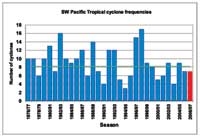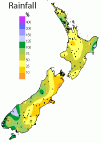Summary of the 2006–07 tropical cyclone season


Stuart Burgess, NIWA
The 2006–07 Southwest Pacific tropical cyclone season had seven occurrences (east of 150°E), one less than the average (1976–77 to 2005–06) number normally expected for the region in the tropical cyclone season (Figure 1), and the same number as the 2005–06 season. ICU tropical cyclone guidance, produced in September 2006, was for an above normal frequency of occurrences in parts of the Southwest Pacific near and east of the Date Line, due to expected weak to moderate El Niño conditions. The first tropical cyclone of the season occurred on 22 October, making this the earliest start to the tropical cyclone season since that of 1997. Such an early start is consistent with El Niño conditions. However, the El Niño dissipated earlier than expected in January, having an effect on the total number of tropical cyclones over the remainder of the season. The last tropical cyclone occurred unusually late in May.
This season’s occurrences were evenly distributed across the Southwest Pacific region, with four tropical cyclones west of the Date Line and three east of the Date Line (see tracks in Figure 2). Rather than the normal February–March peak, there was a fairly even spread of tropical cyclones throughout the season, with the majority of occurrences occurring during the fourth week in several months (October, November, January, and March). February was unusually quiet, with no occurrences. This season, four of the Southwest Pacific region tropical cyclones (57%) reached hurricane strength (sustained wind speeds of at least 118 km), one of which reached major hurricane strength (mean wind speed at least 168 km/h).
Tropical cyclone (TC) Xavier was the first of the season, occurring east of the Solomon Islands on 22 October, and tracked between Vanuatu and Fiji, with maximum sustained winds reaching 213 km/h (major hurricane force). TC Yani occurred over 22–25 November, between the Solomon Islands and Vanuatu, with maximum sustained winds of 120 km/h (hurricane force). TCs Zita and Arthur occurred over the period 23–26 January, both producing wind related damage and coastal flooding in parts of the Austral Islands of Southern French Polynesia, maximum sustained winds being 93 and 120 km/h respectively. TC Becky developed in the Coral Sea south of the Solomon Islands on 26 March with maximum sustained winds of 130 km/h. Becky tracked towards Vanuatu and then veered south toward New Caledonia. Fortunately Becky dissipated on approach to New Caledonia, the highest wind gust reaching 90 km/h there. In Vanuatu, there were fallen trees and damage to crops in Espiritu and Malakula. TC Cliff occurred over the east of Fiji and Southern Tonga from 4–6 April, with maximum sustained wind speeds of 102 km/h. Some eastern parts of Fiji suffered minor wind damage and minor to moderate flooding. TC Pierre was the last of the season, occurring over the southeast of Papua New Guinea and sea area south of the Solomon Islands 17–18 May.
Estimates of maximum sustained wind speeds for named tropical cyclones in the 2006–07 season:
| Name | Origin | Period of occurrence | Estimated maximum sustained wind speed (km/h) | Classification |
|---|---|---|---|---|
| Xavier | East of Solomon Islands | 22–25 October | 213 | Major hurricane |
| Yani | South of Solomon Islands | 22–25 November | 120 | Hurricane |
| Zita | Austral Islands | 23–24 January | 93 | Tropical storm |
| Arthur | Southern Cook Islands & French Polynesia | 24–26 January | 120 | Hurricane |
| Becky | South of Solomon Islands | 26–29 March | 130 | Hurricane |
| Cliff | North of Fiji | 4–6 April | 102 | Tropical storm |
| Pierre | South of Solomon Islands | 17–18 May | 65 | Gale |
